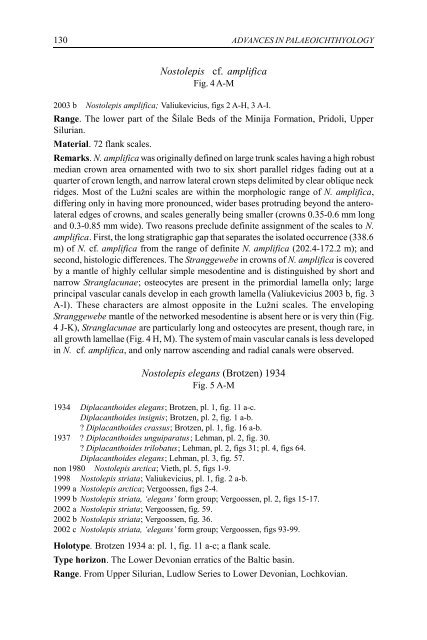Zemes un vides zinātnes Earth and Environment Sciences - Latvijas ...
Zemes un vides zinātnes Earth and Environment Sciences - Latvijas ...
Zemes un vides zinātnes Earth and Environment Sciences - Latvijas ...
Create successful ePaper yourself
Turn your PDF publications into a flip-book with our unique Google optimized e-Paper software.
130<br />
ADVANCES IN PALAEOICHTHYOLOGY<br />
Nostolepis cf. amplifica<br />
Fig. 4 A-M<br />
2003 b Nostolepis amplifica; Valiukevicius, figs 2 A-H, 3 A-I.<br />
Range. The lower part of the Šilale Beds of the Minija Formation, Pridoli, Upper<br />
Silurian.<br />
Material. 72 flank scales.<br />
Remarks. N. amplifica was originally defined on large tr<strong>un</strong>k scales having a high robust<br />
median crown area ornamented with two to six short parallel ridges fading out at a<br />
quarter of crown length, <strong>and</strong> narrow lateral crown steps delimited by clear oblique neck<br />
ridges. Most of the Lužni scales are within the morphologic range of N. amplifica,<br />
differing only in having more prono<strong>un</strong>ced, wider bases protruding beyond the anterolateral<br />
edges of crowns, <strong>and</strong> scales generally being smaller (crowns 0.35-0.6 mm long<br />
<strong>and</strong> 0.3-0.85 mm wide). Two reasons preclude definite assignment of the scales to N.<br />
amplifica. First, the long stratigraphic gap that separates the isolated occurrence (338.6<br />
m) of N. cf. amplifica from the range of definite N. amplifica (202.4-172.2 m); <strong>and</strong><br />
second, histologic differences. The Stranggewebe in crowns of N. amplifica is covered<br />
by a mantle of highly cellular simple mesodentine <strong>and</strong> is distinguished by short <strong>and</strong><br />
narrow Stranglac<strong>un</strong>ae; osteocytes are present in the primordial lamella only; large<br />
principal vascular canals develop in each growth lamella (Valiukevicius 2003 b, fig. 3<br />
A-I). These characters are almost opposite in the Lužni scales. The enveloping<br />
Stranggewebe mantle of the networked mesodentine is absent here or is very thin (Fig.<br />
4 J-K), Stranglac<strong>un</strong>ae are particularly long <strong>and</strong> osteocytes are present, though rare, in<br />
all growth lamellae (Fig. 4 H, M). The system of main vascular canals is less developed<br />
in N. cf. amplifica, <strong>and</strong> only narrow ascending <strong>and</strong> radial canals were observed.<br />
Nostolepis elegans (Brotzen) 1934<br />
Fig. 5 A-M<br />
1934 Diplacanthoides elegans; Brotzen, pl. 1, fig. 11 a-c.<br />
Diplacanthoides insignis; Brotzen, pl. 2, fig. 1 a-b.<br />
? Diplacanthoides crassus; Brotzen, pl. 1, fig. 16 a-b.<br />
1937 ? Diplacanthoides <strong>un</strong>guiparatus; Lehman, pl. 2, fig. 30.<br />
? Diplacanthoides trilobatus; Lehman, pl. 2, figs 31; pl. 4, figs 64.<br />
Diplacanthoides elegans; Lehman, pl. 3, fig. 57.<br />
non 1980 Nostolepis arctica; Vieth, pl. 5, figs 1-9.<br />
1998 Nostolepis striata; Valiukevicius, pl. 1, fig. 2 a-b.<br />
1999 a Nostolepis arctica; Vergoossen, figs 2-4.<br />
1999 b Nostolepis striata, ‘elegans’ form group; Vergoossen, pl. 2, figs 15-17.<br />
2002 a Nostolepis striata; Vergoossen, fig. 59.<br />
2002 b Nostolepis striata; Vergoossen, fig. 36.<br />
2002 c Nostolepis striata, ‘elegans’ form group; Vergoossen, figs 93-99.<br />
Holotype. Brotzen 1934 a: pl. 1, fig. 11 a-c; a flank scale.<br />
Type horizon. The Lower Devonian erratics of the Baltic basin.<br />
Range. From Upper Silurian, Ludlow Series to Lower Devonian, Lochkovian.
















